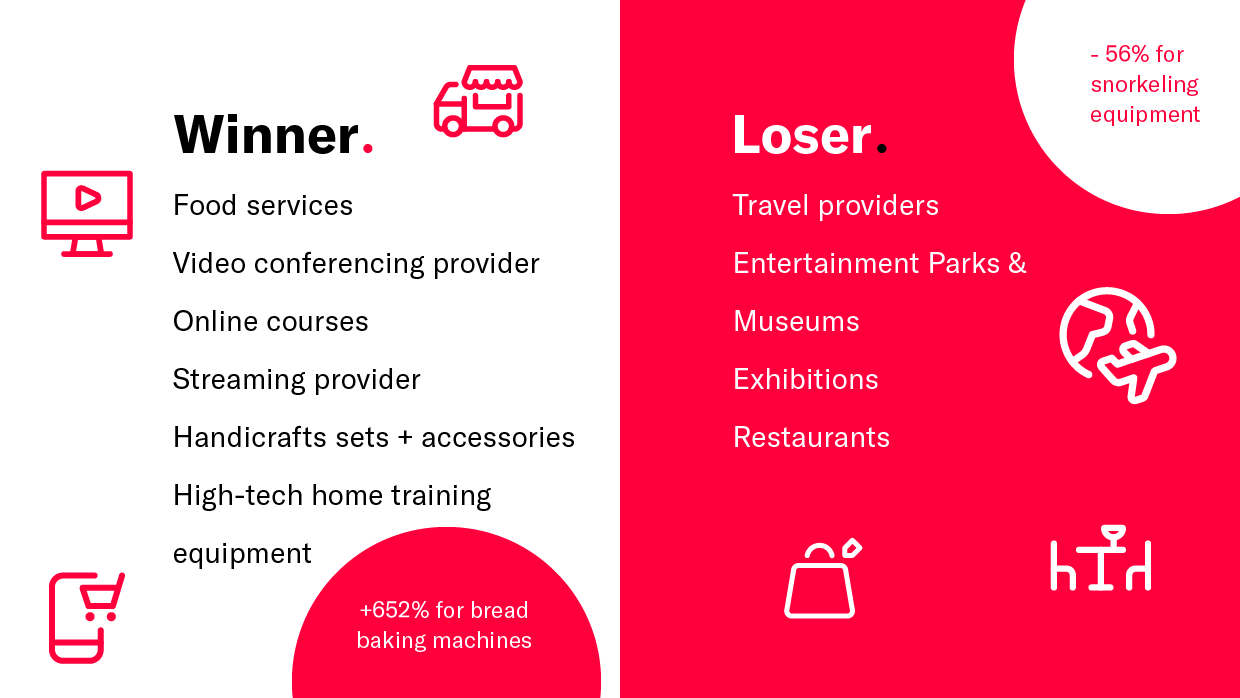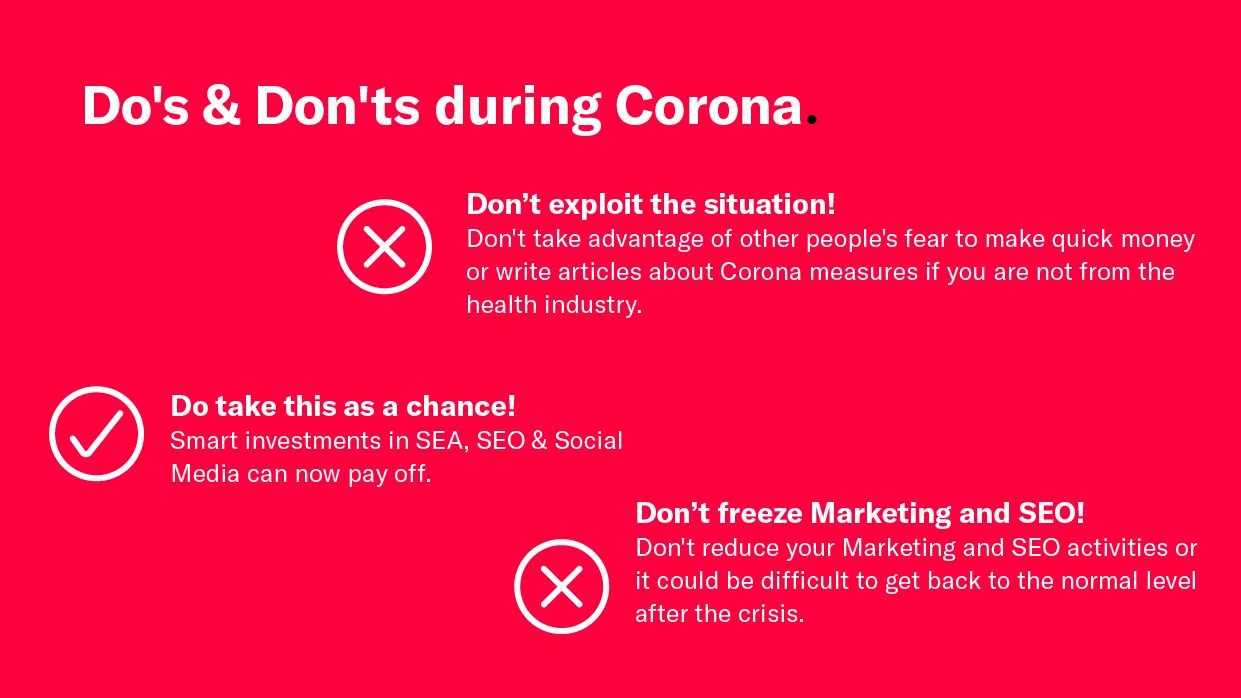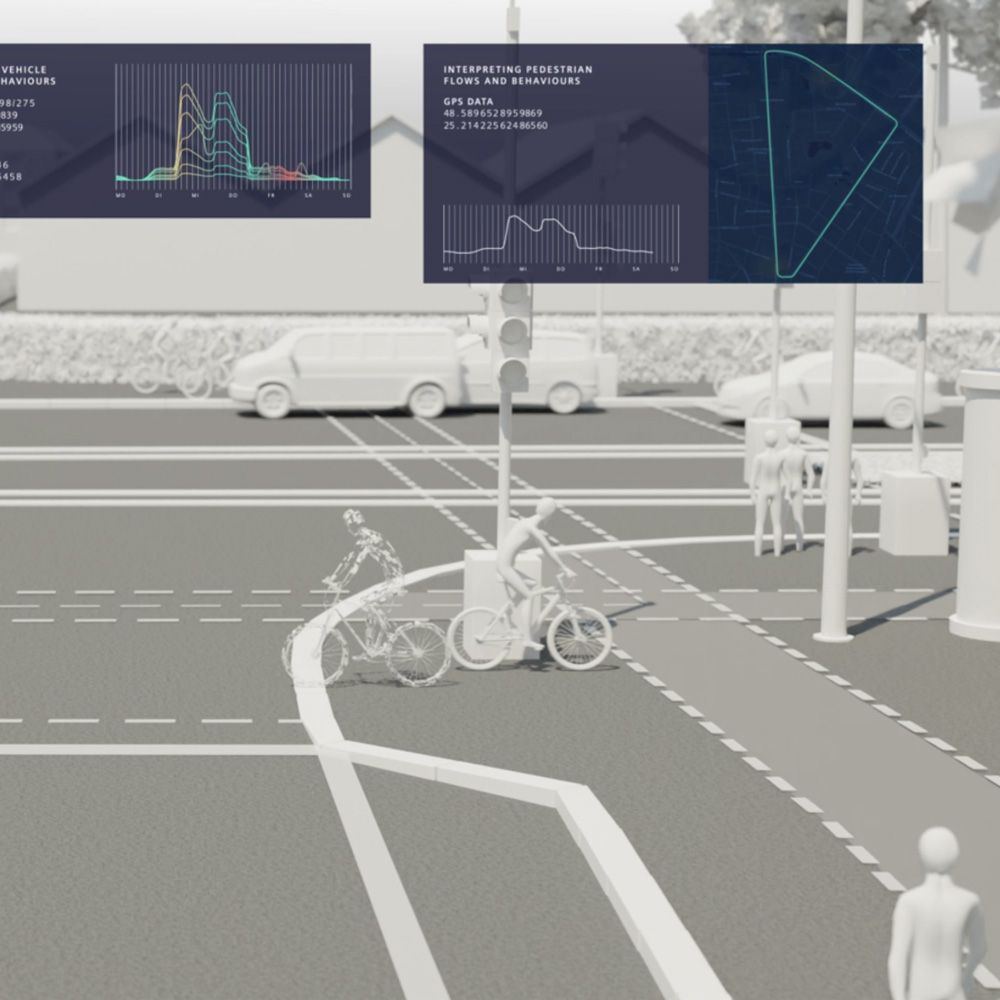Online Marketing Trends in times of Corona
Online marketing is changing in times of Corona. Here you can learn about the resulting trends
The year 2020 brings many challenges. Covid-19 challenges us not only in the private sphere, but many companies are also feeling the immediate consequences. What exactly this means for traffic, turnover and online marketing and what the resulting online marketing trends are, you can find out here.
Development of traffic and consequences
The development of traffic suffers greatly in times of Corona. On average, a clear decline in traffic and, as a result, often a loss of revenue can be seen. Exact consequences on the long-term turnover are not yet fully predictable, as the dynamics of Covid-19 brings constant change. Nevertheless, this development must be viewed in a more differentiated manner. There are industries that are more affected and others that even benefit from Corona. The travel industry, for example, is the hardest hit, with companies losing up to 50% of their traffic on average. But also companies whose focus is on events or leisure parks are moving into similar spheres. Retail, insurance or even the real estate industry loose on average about 20% of their traffic (source: neilpatel.com). Due to the loss of traffic, it is not yet possible to predict the exact sales development.
The winners, on the other hand, are companies from the financial sector, the food industry or the health sector, which on average gain between 15 and 30 % of traffic. Social media are gaining about 35% more traffic (source: neilpatel.com), which means great potential, especially in terms of possible marketing activities, so that social media marketing is gaining relevance. Services such as online delivery services for food, streaming or online news agencies benefit from the higher online presence, as do health portals and online healthcare services. Although there are companies such as Microsoft, Google, Salesforce and Zoom that offer free video conferencing services to promote minimal physical contact with people, the trend is towards more online marketing. This can definitely be a great opportunity for these brands to attract users to their platform to convert them as paid users later. We have listed some examples of winners and losers below.

How do users behave?
An increase in traffic does not automatically mean more sales or more conversions. In general, there is a clear decline in the conversion rate (source: neilpatel.com), but it does not fall to the same extent as the traffic. On average, conversions in all industries, except the food industry, fall by an average of about 20% (source: neilpatel.com). Users are thus becoming more price-sensitive due to the economic situation, but click rates remain stable.
In addition, the period during which people are online has continued to increase, which brings new potential. The "work from home" policy is leading to more use of digital media and online services, not only for work, but also for private purposes. As a result, brands that already serve the so-called "sofa surfers" will most likely not experience too much difficulty and may even see an increase in sales. Brands that are traditionally offline will probably have to develop new online products to adapt to this new lifestyle.
Terms such as podcasts, TikTok, and Netflix are now much more widely searched on Google, expanding advertising opportunities. People are looking for more ways to escape and entertain themselves: they download gaming apps, spend even more time in social media and stream more movies. And between distance learning arrangements and live streaming training courses, university lectures and social engagements, we're testing the bandwidth of our homes in a pre-5G world. Users are being forced to digitalize, and so the search volume for providers such as Zoom or Google Hangouts is skyrocketing. And the search volume for online shops such as Zalando or Blume2000 (source: searchengineland.com) is also rising very fast. The distribution of content via various new media should therefore be addressed and is also one of the online marketing trends.
What does this mean for your online marketing activities?
As already indicated, Covid-19 and the resulting change should be seen as an opportunity. It is important to stay in touch with users, regardless of whether you are a loser or winner of Corona. People are becoming more digital as a result of the crisis and therefore the way of addressing customers should also become more digital. Reply to comments on any platform you serve and show users that you are still there for them. Brand Marketing & Brand Communication are the be-all and end-all in times of crisis: "We are there for you": Feel-good content that alleviates anxiety and promotes positive news makes a significant contribution to strengthening the brand. Social media, newsletters, sponsoring or the findability on Google are becoming more and more relevant especially in these times and are becoming online marketing trends. Freezing the marketing budget completely makes little sense, because users should still remember you even after Corona. Many companies have already recognized this. Recent research has shown that 61% of marketers change their short-term media strategy. However, only 9% make long-term changes (source: match2one.com). Furthermore, they should refrain from taking advantage of the current crisis. It is not expedient to trim one's own content to keywords such as Corona or similar in order to rank as high as possible in Google. Google punishes such a thing and other channels are also slowly catching up here. Furthermore, no data (search volume, CPC, level of competition, etc.) is available for keywords related to Corona in Google Ads, in the Keyword Planner. The Medic Update from August 2018 also plays a role for Google. Content that directly affects the lives of users, such as content related to Corona, is more strictly controlled by Google. Users should only be presented with really helpful and sound information that they can rely on.

Search Engine Advertising (SEA) as the loser
However, SEA measures are a special case here. Here I observe in my daily work that conversion rates on this channel are falling sharply. Here I recommend to reduce the budget. However, the budget should not be frozen here either. Here it is important to analyse your own account and your campaigns exactly and to let successful campaigns continue. For campaigns in which you observe a sharp decline in figures since Corona, you should reduce the budget. A detailed audit of your ad account is therefore indispensable in times of Covid-19.
These channels are becoming increasingly relevant
As already described above, social media is becoming more relevant. People spend more time on their smartphones, so they are more receptive to marketing activities on social media, especially with regard to content marketing. Newsletters are also a good way to stay in touch with customers and are among the current online marketing trends. My colleague Carolina Bauer has already written an exciting blog series on the topic of newsletters here. In addition, it is essential to appear as high up in the Google results as possible. That's why especially losers of Covid-19 should do their best to do SEO. It is important to generate attention, which you can reach very well via good rankings on Google or social media ads. The change to flexible channels is essential. Marketers who are seeing budget cuts will benefit by switching to cheaper and more flexible channels such as programmatic advertising (Programmatics) where consumer presence and available impressions increase. Digital display ads, social media and online video are channels that are growing in the short-term media plan.
Would you like to learn more about SEO, social media or newsletter marketing or are you interested in a check of your Google Ads account? Then get in touch with us.










